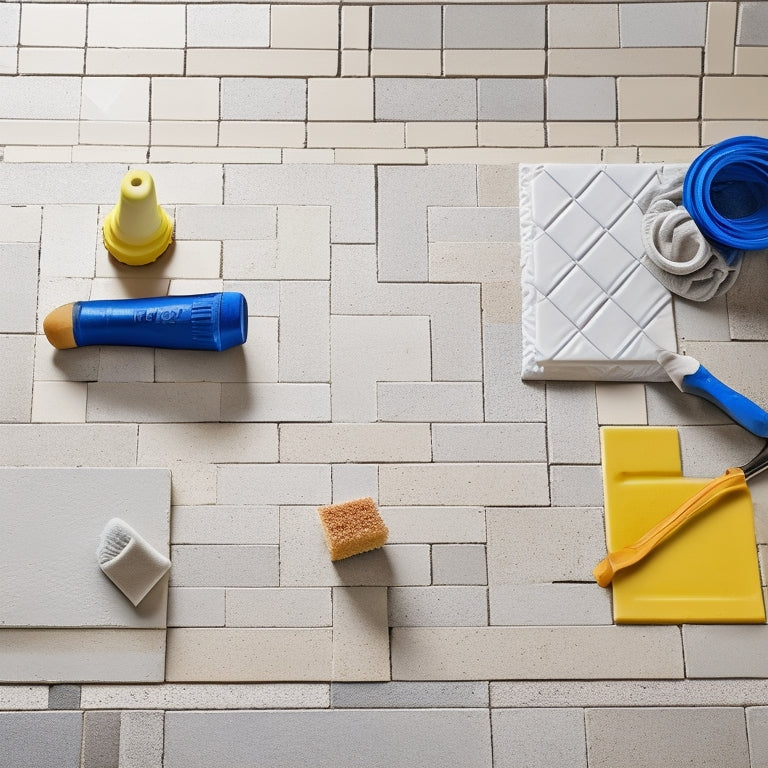
5 Best Grouting Tool Selection Criteria for Home Renovation
Share
When selecting a grouting tool for your home renovation project, you'll want to take into account five key criteria that impact the quality of your grout job. First, assess the tool's ability to work with varying grout viscosities to achieve ideal flow and coverage. Next, evaluate the tool's durability and longevity, as high-quality materials and sturdy construction can save you time and money in the long run. Additionally, think about the tool's ease of cleaning and maintenance, comfort and ergonomic design, and cost-effectiveness regarding budget and ROI. By weighing these factors, you'll be well on your way to choosing the right tool for a successful grout job, and understanding these nuances can make all the difference.
Key Takeaways
• Consider grout flow and coverage ability when selecting a tool, as it affects the quality of the grout job and overall project success.
• Evaluate tool durability and longevity to ensure it withstands heavy use and minimizes replacement costs.
• Look for tools with easy cleaning and maintenance features to reduce downtime and extend tool lifespan.
• Prioritize comfort and ergonomic design to reduce fatigue and promote precision and control during grouting tasks.
• Weigh tool cost against project budget and consider the long-term cost-effectiveness of manual versus more expensive tools.
Grout Flow and Coverage Ability
When selecting a grouting tool, you must consider the grout's flow and coverage ability, as it directly affects the tool's ability to efficiently and effectively fill joints and gaps.
The grout's flow is largely determined by its viscosity, which can range from very fluid to quite thick. A grout with low viscosity will flow easily and cover a large area, but may be more prone to shrinkage and cracking. On the other hand, a grout with high viscosity will be more difficult to spread, but will provide a stronger, more durable bond.
To guarantee ideal results, you should choose a grouting tool that's compatible with the grout's viscosity. For instance, a tool with a stiffer blade may be better suited for thicker grouts, while a tool with a more flexible blade may be more effective with thinner grouts.
Additionally, your application technique plays a significant role in achieving proper coverage. By using the right tool and technique, you can guarantee a smooth, even application that meets your project's requirements.
Tool Durability and Longevity
You'll also want to appraise the grouting tool's durability and longevity, as a tool that can withstand repeated use and harsh job site conditions will help you maintain productivity and reduce replacement costs.
When evaluating durability, contemplate the material quality of the tool. Look for tools made from high-quality materials that can resist corrosion, abrasion, and damage from heavy use. A well-built tool with a sturdy construction will be able to withstand the rigors of grouting and last longer.
Another important factor to reflect on is the product warranty offered by the manufacturer. A thorough warranty that covers defects and performance issues can provide peace of mind and protect your investment.
A reputable manufacturer that stands behind their product with a solid warranty is more likely to produce a high-quality tool that will last. By appraising the durability and longevity of a grouting tool, you can make an informed decision that will save you time and money in the long run.
Ease of Cleaning and Maintenance
As you evaluate grouting tools, consider the importance of effortless cleaning and maintenance, which can greatly impact your productivity and overall job satisfaction. A grouting tool that's easy to clean and maintain will save you time and reduce frustration, allowing you to focus on the task at hand.
Look for tools with smooth, non-porous surfaces that won't harbor grout residue or bacteria. Additionally, consider tools with detachable parts or easy-to-access crevices, making cleaning a breeze.
When it comes to maintenance frequency, you'll want a tool that requires minimal upkeep. Opt for tools with rust-resistant materials or those that come with a protective coating. This will reduce the need for frequent cleaning and maintenance.
Moreover, consider the cleaning techniques required for each tool. Some may require specialized cleaning solutions or scrubbers, while others can be easily wiped down with a damp cloth.
Comfort and Ergonomic Design
Selecting a grouting tool with a comfortable, ergonomic design can greatly reduce fatigue and discomfort, allowing you to work efficiently for extended periods without sacrificing precision or control. This is especially important when working on large-scale grouting projects that require prolonged use of the tool.
When evaluating a grouting tool's comfort and ergonomic design, consider the following key factors:
-
Hand grip: A contoured hand grip that fits comfortably in your hand can reduce strain and discomfort, allowing you to maintain a secure grip even in wet or slippery conditions.
-
Tool weight: A lightweight tool with balanced weight distribution can reduce fatigue and strain, making it easier to maneuver and control.
-
Ergonomic shape: A tool with an ergonomic shape that fits comfortably in your hand and allows for natural wrist and arm alignment can reduce strain and discomfort.
Budget and Cost-Effectiveness Factor
Determining your budget and evaluating the cost-effectiveness of a grouting tool is essential, as it directly impacts your project's overall expense and return on investment. You must consider your budget constraints and prioritize your spending to guarantee you get the best value for your money. A cost comparison of different grouting tools can help you make an informed decision.
| Grouting Tool | Cost-Effectiveness |
|---|---|
| Manual Grout Float | Low cost, high labor effort |
| Electric Grout Float | Moderate cost, medium labor effort |
| Grout Pump | High cost, low labor effort |
| Grout Brush | Very low cost, high labor effort |
When evaluating the cost-effectiveness of a grouting tool, consider not only the initial purchase price but also the long-term costs, such as maintenance, replacement parts, and labor costs. A tool that may seem expensive initially may end up saving you time and money in the long run. By considering your budget and prioritizing your needs, you can make a cost-effective decision that meets your project's requirements.
Frequently Asked Questions
Can I Use a Grouting Tool for Both Sanded and Unsanded Grout?
You can use a grouting tool for both sanded and unsanded grout, but it is crucial to choose the right tool type and adjust the technique, as sanded grout requires more pressure and unsanded grout demands a gentler touch.
Are Grouting Tools Suitable for All Types of Tile and Stone Surfaces?
'Think you can slap any grout on any surface? Think again! You'll need to guarantee your tool is compatible with the tile type, and the surface is properly prepared, or you'll be left with a mess on your hands.'
Do I Need to Wear Protective Gear When Using a Grouting Tool?
When using a grouting tool, you'll need to wear protective equipment, like gloves and goggles, to prevent grout and debris from damaging your skin and eyes, and take safety precautions to avoid respiratory issues.
Can I Use a Grouting Tool for Other DIY Projects Beyond Grouting?
You'll be surprised by a grouting tool's versatility; it's not just for grouting. You can repurpose it for various DIY project applications, like mixing adhesives, applying sealants, or even scraping old paint, making it a valuable addition to your toolkit.
Are There Any Specific Storage Requirements for Grouting Tools?
When you're not wielding your trusty grouting tool, it's essential you 'tuck it in' correctly. You'll want to store it in a dry, secure space with controlled storage conditions, ensuring proper tool organization to prolong its lifespan.
Conclusion
To sum up, you've got the lowdown on the top 5 grouting tool selection criteria for your home renovation. By considering grout flow and coverage, tool durability, ease of cleaning, comfort, and budget, you'll be well on your way to a successful project.
Curiously, did you know that a well-grouted tile floor can last up to 20 years longer than a poorly grouted one? With the right tool, you can guarantee a beautiful, long-lasting finish that will stand the test of time.
Related Posts
-

Top Tools for DIY Home Renovation Plastering Success
To achieve DIY home renovation plastering success, you'll need a range of essential tools. Start with hand tools like...
-

What Tools to Rent for Block Wall Renovation
When renovating a block wall, it's vital to have the right tools for the job. You'll need demolition tools like pry b...
-

What to Look for in Pneumatic Renovation Tools
When selecting pneumatic renovation tools, you'll want to take into account several key factors to guarantee optimal ...


